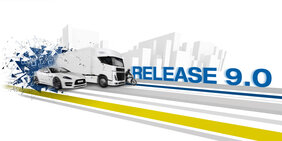From cooperative driving with SimNet, advanced and new sensor models to the parallelization of multiple GPUs - the release 9.0 of the CarMaker Product Family includes numerous new, innovative applications for virtual vehicle development. In response to the societal megatrends digitization and autonomous driving leading to higher validation efforts in vehicle development, the Karlsruhe-based company consolidated its products particularly in the fields of performance and flexibility of scenarios.
With the release 9.0, the calculations of Radar RSI switch to physically based field calculations. A wide range of effects are thereby considered before the raw data are then processed in a signal processing model. Radar RSI was validated in an extensive measurement campaign in cooperation with Magna Electronics, one of the leading automotive suppliers.
To support the functionality tests more extensively, the Camera HiFi Sensor is added to the list of High Fidelity (HiFi) Sensors. It generates camera specific object lists of recognized traffic objects, traffic signs and traffic lights. Various effects need to be taken into consideration, as for example occlusion or influence from rain or fog.
Further, the release 9.0 introduces a new Ideal Sensor. The Object by Lane Sensor identifies traffic objects on selected, adjacent traffic lanes and provides information about the lanes as well as about the traffic objects using them. That is why the sensor is perfectly suitable for trajectory planning.
Flexible and detailed scenario generation
In order to provide a quick and easy access to realistic road networks in CarMaker, map data including road characteristics as lanes, lane markings and speed limits from HERE HD Live Maps is available for import. The user decides whether to load a selected section of a road network or the required roads along a definable route.
The release 9.0 enables exports of road networks created with the Scenario Editor not only in the ROAD5 format but also in the open OpenDRIVE format. In this way, the user can exchange with other platforms and once produced road networks can be reused more often.
Other new features in the Scenario Editor include new possibilities for an easy definition of traffic signs and traffic lights as well as the corresponding functional markings. By allocating different speed limits to different traffic lanes on the road and through traffic lights located on the opposite sides of an intersection, the user profits from maximum flexibility when configurating scenarios.
As of now and in addition to the so far generic Traffic Model, a Human Driver Model is available. The behavior is thereby not only enhanced during lane switching, but also models human traits as reaction time or imprecise estimations of distance and speed. Therefore, the behavior of road users appears more realistic and humanlike.
Cooperative driving with SimNet through co-simulation of various prototypes in a common scenario
The use of cooperative driving as basis for applications such as V2X communication or platooning has already been possible for some time with the simulation solutions of the CarMaker product family. With the release 9.0, cooperative driving with SimNet now becomes a regular feature. It allows for simulation in one common scenario of up to ten ego vehicles on one computer or up to three ego vehicles in a network of CarMaker, TruckMaker or MotorcycleMaker.
Great scalability through support of CarMaker in Docker containers
Containers facilitate a stable virtual environment for example when running an application in the cloud. The new release enables simulation solutions in the CarMaker product family to be carried out in one Docker container. Easy portability and excellent scalability can therefore be reached.
